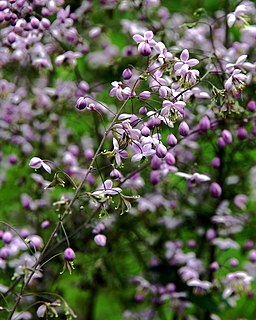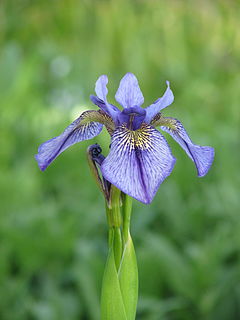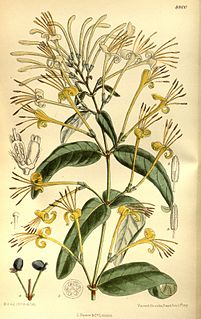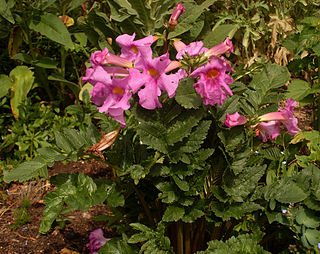
The peony or paeony is a flowering plant in the genus Paeonia, the only genus in the family Paeoniaceae. Peonies are native to Asia, Europe and Western North America. Scientists differ on the number of species that can be distinguished, ranging from 25 to 40, although the current consensus is 33 known species. The relationships between the species need to be further clarified.

Bergenia is a genus of ten species of flowering plants in the family Saxifragaceae, native to central Asia, from Afghanistan to China and the Himalayan region.

Père Jean-Marie Delavay was a French missionary, explorer and botanist. He was perhaps the first Western explorer of the region which is now encompassed by the Three Parallel Rivers of Yunnan Protected Areas.

Magnolia delavayi is a species of flowering plant in the genus Magnolia. It is known by the common names of Chinese evergreen magnolia or Delavay's magnolia. It was named after Father Delavay, French Catholic missionary in China, who collected it.

Thalictrum is a genus of 120-200 species of herbaceous perennial flowering plants in the buttercup family, Ranunculaceae, native mostly to temperate regions. Meadow-rue is a common name for plants in this genus.

Osmanthus is a genus of about 30 species of flowering plants in the family Oleaceae. Most of the species are native to eastern Asia ,and was originally found in the middle east of the Himalayas, with a few species from the Caucasus, New Caledonia, and Sumatra. Osmanthus has been known in China since ancient times with the earliest writings coming from the Warring States period; the book Sea and Mountain. South Mountain states: "Zhaoyao Mountain had a lot of Osmanthus".

Podophyllum is an herbaceous perennial plant in the family Berberidaceae, described as a genus by Linnaeus in 1753. In the past, several species were included in the genus, but all but one have been transferred to other genera (Dysosma and Sinopodophyllum). The one remaining species is Podophyllum peltatum, with common names mayapple, American mandrake, wild mandrake, and ground lemon. It is widespread across most of the eastern United States and southeastern Canada.

Incarvillea is a genus of about 16 species of flowering plants in the family Bignoniaceae, native to central and eastern Asia, with most of the species growing at high altitudes in the Himalaya and Tibet. The most familiar species is Incarvillea delavayi, a garden plant commonly known as hardy gloxinia or Chinese trumpet flower. Unlike most other members of Bignoniaceae, which are mainly tropical woody plants, species of Incarvillea are herbaceous perennial plants from temperate regions.

Abies delavayi, the Delavay's silver-fir or Delavay's fir, is a species of fir, native to Yunnan in southwest China and adjoining border areas in southeastern Tibet, far northeastern India, northern Myanmar, and far northwestern Vietnam. It is a high altitude mountain tree, growing at elevations of 3,000–4,000 m, often occupying the tree line.

Metapanax is a genus of flowering plants in the family Araliaceae, comprising 2 species. They are endemic to southern China and Vietnam.
Calanthe delavayi is a species of plant in the family Orchidaceae. It is endemic to China.
Habenaria delavayi is a species of plant in the family Orchidaceae. It is endemic to China.

Paeonia delavayi is a low woody shrub belonging to the peonies, that is endemic to China. The vernacular name in China is 滇牡丹. In English it is called Delavay's tree peony, Delavay peony, Dian peony, and dian mu dan. It mostly has red brown to yellow, nodding flowers from mid May to mid June. The light green, delicate looking deciduous leaves consist of many segments, and are alternately arranged on new growth.

Thalictrum delavayi, Chinese meadow-rue, is a species of flowering plant in the family Ranunculaceae native to China. Growing to 1.2 m (4 ft) tall by 60 cm (24 in) wide, it is a herbaceous perennial with leaves divided into many small leaflets, and panicles of lilac flowers with green or white stamens in summer.

Osmanthus delavayi is a species of flowering plant in the olive family Oleaceae. It is an evergreen shrub native to the Guizhou, Sichuan and Yunnan regions of southern China, and widely cultivated as an ornamental in temperate and subtropical zones elsewhere.

Iris delavayi is a species of flowering plant in the subgenus Limniris and in the series Sibiricae of the family Iridaceae. This rhizomatous herbaceous perennial comes from various provinces in China. It has grey-green leaves, long hollow stem, and 2 flowers in various blue shades. From dark violet, dark purple, purple-blue, dark blue to light purple. It is cultivated as an ornamental plant in temperate regions.
Quercus delavayi is an Asian species of trees in the beech family. It has been found only in southern China, in the Provinces of Guizhou, Hubei, Sichuan, Yunnan, and Guangxi.

Lonicera similis is a species of flowering plant in the family Caprifoliaceae, native to Western China. This honeysuckle is known in cultivation by the variety delavayi which is reported by some authorities to be synonymous with L. similis itself. It is a large, twining, semi-evergreen shrub growing to 8 m (26 ft) tall by 1.5 m (4.9 ft) broad, with a profusion of fragrant tubular flowers opening white and ageing to yellow, in late summer and autumn. The flowers are followed by black berries. The Latin specific epithet similis means “similar to”. It is similar in appearance to L. japonica, but larger and more robust. The name delavayi honours the French missionary and botanist Père Jean Marie Delavay (1834-1895).

Podophyllum pleianthum, the many-flowered Chinese mayapple, is a species of flowering plant in the genus Podophyllum, native to south-central and southeast China, including Taiwan. Shade tolerant, and deer resistant due to its toxicity, it has gained the Royal Horticultural Society's Award of Garden Merit.

Incarvillea delavayi, the so‑called hardy gloxinia or flowering fern, is a species of flowering plant in the family Bignoniaceae, native to western Sichuan and northwest Yunnan provinces of China. The true Gloxinia are members of the Gesneriaceae, while true ferns are flowerless plants which reproduce through spores.
















